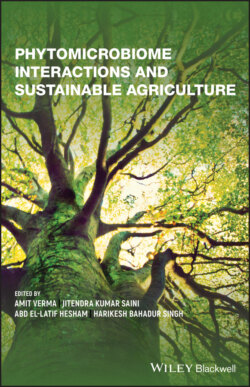Читать книгу Phytomicrobiome Interactions and Sustainable Agriculture - Группа авторов - Страница 16
1.3 Role of Root Exudates in Shaping Rhizospheric Microbiomes
ОглавлениеRoot exudate composition resembles the plant constitution and its release of the organic compounds from the root zone allows it to participate in the rhizodeposition process (Jones and Darrah 1995). Root exudation is composed of a tremendous range of chemical compounds, including primary as well as secondary metabolites, ions, mucilage, reactive oxygen molecules, water molecules, amino acids, enzymes, peptides, sugars, vitamins, nucleotides, organic acids, plant inhibitors, growth regulators, sterols, fatty acids, phenolic compounds, flavonoids, and other miscellaneous chemicals (Bais et al. 2006; Huang et al. 2014; Tsuno et al. 2019). Root exudates contain the capacity to modulate the plant microbe interaction in the rhizosphere (De Weert et al. 2002; Zwetsloot et al. 2019). Moreover, these chemical compounds help microbes in the activity in the soil around the root, which is beneficial to plant development as well as to regain soil fertility.
Legume plants are considered an excellent example of shaping rhizospheric microbes through nitrogen assimilation through symbiotic associations of rhizobacteria. The key factor of plant rhizobia interaction in shaping rhizosphere is that flavonoid composition exists in the root exudates of legumes (Abdel Lateif et al. 2012; Weston and Mathesius 2013). Recently, researchers focused on microorganisms other than rhizobiums, which have the capacity of nitrogen fixation, such as cyanobacteria, Frankia, diazotrophsbacteria, etc. Several non‐leguminous plants have rhizobia for nitrogen fixation, such as in Parasponiasp. (family Cannabaceae), which may assist in the shaping of rhizospheric microbes.
Altering the behavioral changes in microorganisms through the effect of root exudates is proven and has been recently termed as “rhizosphere engineering”. In A. thaliana, root secretion possesses antimicrobial compounds that are responsible for its resistance to many non‐host pathogens that are present in the rhizosphere. Phenolic compounds and antimicrobial protein of root exudates may help in guarding the roots against potential pathogens (Bais et al. 2005). In experimental research, evidence shows that root exudate diversity is a crucial link between plant diversity and soil microorganisms (Steinauer et al. 2016). For better dynamic in‐depth interaction knowledge apart from phenolic compounds, flavonoid molecules and several biomolecules possess the capacity to increase favor around the rhizosphere. There are enormous biological molecules in root exudates, such as rosmarinic acid, jasmonic acid, and napthoquinones, which direct microbes toward plants for mutual benefit (Brigham et al. 1999; Bais et al. 2002; Carvalhais et al. 2015). Furthermore, there are few biomolecules, such as flavonoid, strigolactones, and terpenoids, which assist plants in specifically attracting the beneficial counter‐partner through root signals (Vranova et al. 2013; Lareen et al. 2016; Massalha et al. 2017). Mutualistic interactions, nodulation and mycorrhizal interactions, signal perception and transduction such as receptor‐like kinases (RLKs) are the signal‐based interaction of plant and microbes (Lagunas et al. 2015).
In the consecutive discussion, root excaudate’s role as a messenger that communicates within rhizosphere is examined. This perspective is well defined in root–root communication involved in an allelopathy phenomenon in the rhizosphere, which contributes in agricultural growth, because rhizospheric allelochemicals are protective in nature for plants. Root microbe communication in the rhizosphere may enhance the plant biomass through an increase in nutrition uptake, secretion of phytohormones, and helps in defense of the plant (Robin et al. 2008).
